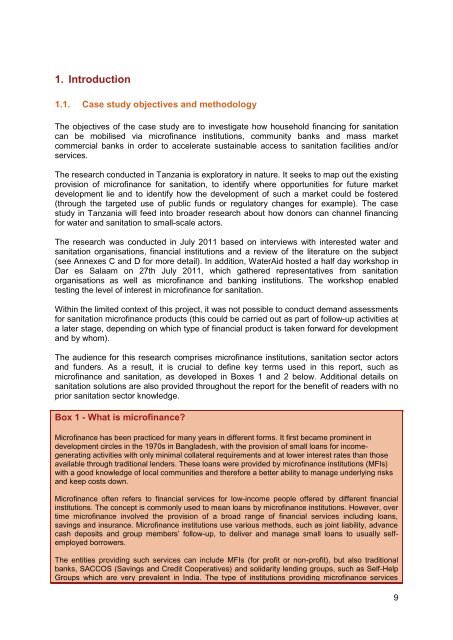REPORT__Evaluating_the_potential_of_microfinance_for_sanitation_in_Tanzania_May_2013
REPORT__Evaluating_the_potential_of_microfinance_for_sanitation_in_Tanzania_May_2013
REPORT__Evaluating_the_potential_of_microfinance_for_sanitation_in_Tanzania_May_2013
Create successful ePaper yourself
Turn your PDF publications into a flip-book with our unique Google optimized e-Paper software.
1. Introduction<br />
1.1. Case study objectives and methodology<br />
The objectives <strong>of</strong> <strong>the</strong> case study are to <strong>in</strong>vestigate how household f<strong>in</strong>anc<strong>in</strong>g <strong>for</strong> <strong>sanitation</strong><br />
can be mobilised via micr<strong>of</strong><strong>in</strong>ance <strong>in</strong>stitutions, community banks and mass market<br />
commercial banks <strong>in</strong> order to accelerate susta<strong>in</strong>able access to <strong>sanitation</strong> facilities and/or<br />
services.<br />
The research conducted <strong>in</strong> <strong>Tanzania</strong> is exploratory <strong>in</strong> nature. It seeks to map out <strong>the</strong> exist<strong>in</strong>g<br />
provision <strong>of</strong> micr<strong>of</strong><strong>in</strong>ance <strong>for</strong> <strong>sanitation</strong>, to identify where opportunities <strong>for</strong> future market<br />
development lie and to identify how <strong>the</strong> development <strong>of</strong> such a market could be fostered<br />
(through <strong>the</strong> targeted use <strong>of</strong> public funds or regulatory changes <strong>for</strong> example). The case<br />
study <strong>in</strong> <strong>Tanzania</strong> will feed <strong>in</strong>to broader research about how donors can channel f<strong>in</strong>anc<strong>in</strong>g<br />
<strong>for</strong> water and <strong>sanitation</strong> to small-scale actors.<br />
The research was conducted <strong>in</strong> July 2011 based on <strong>in</strong>terviews with <strong>in</strong>terested water and<br />
<strong>sanitation</strong> organisations, f<strong>in</strong>ancial <strong>in</strong>stitutions and a review <strong>of</strong> <strong>the</strong> literature on <strong>the</strong> subject<br />
(see Annexes C and D <strong>for</strong> more detail). In addition, WaterAid hosted a half day workshop <strong>in</strong><br />
Dar es Salaam on 27th July 2011, which ga<strong>the</strong>red representatives from <strong>sanitation</strong><br />
organisations as well as micr<strong>of</strong><strong>in</strong>ance and bank<strong>in</strong>g <strong>in</strong>stitutions. The workshop enabled<br />
test<strong>in</strong>g <strong>the</strong> level <strong>of</strong> <strong>in</strong>terest <strong>in</strong> micr<strong>of</strong><strong>in</strong>ance <strong>for</strong> <strong>sanitation</strong>.<br />
With<strong>in</strong> <strong>the</strong> limited context <strong>of</strong> this project, it was not possible to conduct demand assessments<br />
<strong>for</strong> <strong>sanitation</strong> micr<strong>of</strong><strong>in</strong>ance products (this could be carried out as part <strong>of</strong> follow-up activities at<br />
a later stage, depend<strong>in</strong>g on which type <strong>of</strong> f<strong>in</strong>ancial product is taken <strong>for</strong>ward <strong>for</strong> development<br />
and by whom).<br />
The audience <strong>for</strong> this research comprises micr<strong>of</strong><strong>in</strong>ance <strong>in</strong>stitutions, <strong>sanitation</strong> sector actors<br />
and funders. As a result, it is crucial to def<strong>in</strong>e key terms used <strong>in</strong> this report, such as<br />
micr<strong>of</strong><strong>in</strong>ance and <strong>sanitation</strong>, as developed <strong>in</strong> Boxes 1 and 2 below. Additional details on<br />
<strong>sanitation</strong> solutions are also provided throughout <strong>the</strong> report <strong>for</strong> <strong>the</strong> benefit <strong>of</strong> readers with no<br />
prior <strong>sanitation</strong> sector knowledge.<br />
Box 1 - What is micr<strong>of</strong><strong>in</strong>ance?<br />
Micr<strong>of</strong><strong>in</strong>ance has been practiced <strong>for</strong> many years <strong>in</strong> different <strong>for</strong>ms. It first became prom<strong>in</strong>ent <strong>in</strong><br />
development circles <strong>in</strong> <strong>the</strong> 1970s <strong>in</strong> Bangladesh, with <strong>the</strong> provision <strong>of</strong> small loans <strong>for</strong> <strong>in</strong>comegenerat<strong>in</strong>g<br />
activities with only m<strong>in</strong>imal collateral requirements and at lower <strong>in</strong>terest rates than those<br />
available through traditional lenders. These loans were provided by micr<strong>of</strong><strong>in</strong>ance <strong>in</strong>stitutions (MFIs)<br />
with a good knowledge <strong>of</strong> local communities and <strong>the</strong>re<strong>for</strong>e a better ability to manage underly<strong>in</strong>g risks<br />
and keep costs down.<br />
Micr<strong>of</strong><strong>in</strong>ance <strong>of</strong>ten refers to f<strong>in</strong>ancial services <strong>for</strong> low-<strong>in</strong>come people <strong>of</strong>fered by different f<strong>in</strong>ancial<br />
<strong>in</strong>stitutions. The concept is commonly used to mean loans by micr<strong>of</strong><strong>in</strong>ance <strong>in</strong>stitutions. However, over<br />
time micr<strong>of</strong><strong>in</strong>ance <strong>in</strong>volved <strong>the</strong> provision <strong>of</strong> a broad range <strong>of</strong> f<strong>in</strong>ancial services <strong>in</strong>clud<strong>in</strong>g loans,<br />
sav<strong>in</strong>gs and <strong>in</strong>surance. Micr<strong>of</strong><strong>in</strong>ance <strong>in</strong>stitutions use various methods, such as jo<strong>in</strong>t liability, advance<br />
cash deposits and group members’ follow-up, to deliver and manage small loans to usually selfemployed<br />
borrowers.<br />
The entities provid<strong>in</strong>g such services can <strong>in</strong>clude MFIs (<strong>for</strong> pr<strong>of</strong>it or non-pr<strong>of</strong>it), but also traditional<br />
banks, SACCOS (Sav<strong>in</strong>gs and Credit Cooperatives) and solidarity lend<strong>in</strong>g groups, such as Self-Help<br />
Groups which are very prevalent <strong>in</strong> India. The type <strong>of</strong> <strong>in</strong>stitutions provid<strong>in</strong>g micr<strong>of</strong><strong>in</strong>ance services<br />
9


